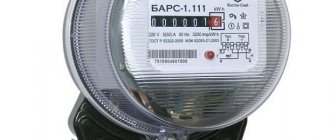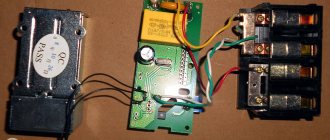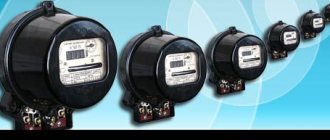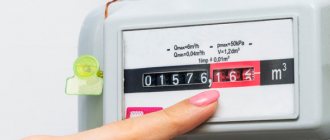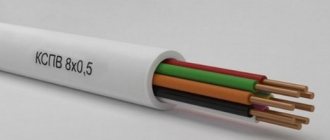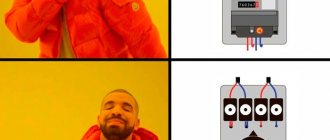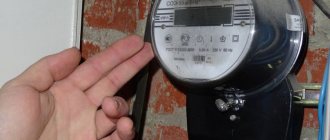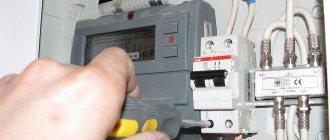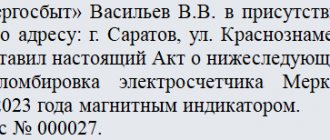General requirements for meters
The device must comply with the register of those approved for installation on the territory of the Russian Federation
Any of the specified types of electrical metering devices must meet several mandatory requirements:
- compliance with the register - a list of imported and domestic brands of manufacturers that have passed certification, certification and are approved for installation on the territory of the Russian Federation;
- registration after putting into operation a new device or upgrading an old one (any changes, internal or external, are considered), it is important to check the correspondence of the device readings and the data recorded in the report;
- installation height – no more than 1.7 meters from the floor level;
- the corresponding service life of the electricity meter in the apartment.
If the device does not pass the test on at least one of the points, its readings are not taken into account. Penalties may be imposed. This is especially true for large industrial facilities with significant levels of light consumption.
Meter usage period
All control devices have a note in their passport indicating that a check was carried out, based on the results of which the meter is allowed to operate.
There is another mark nearby indicating when the next test should be carried out.
At the same time, the question often arises as to why additional verification is needed if the passport indicates the expiration date of the electric meter in the apartment.
Any electric meter has its own service life and expiration date. It is important to consider that these are not the same thing.
In most cases, the period for replacing the electric meter in an apartment should be after 25 years. The operating period is shorter.
This fact is explained by the fact that the device is constantly in operation and this affects the wear of its parts. This is often observed in induction models.
After a certain period of time, the meter begins to show a significant percentage of error . To detect this in a timely manner and carry out repairs, a calibration interval is established.
This means that after some time, the manufacturer does not guarantee accurate readings unless a control check is carried out.
For each model, the verification interval is not the same; it is reflected in the device passport.
The calculation of the interval begins from the moment the device is put into operation, but not from its purchase or production date. Eg:
- For single-phase models it is 2 years.
- For three-phase meters – 1 year.
If during the time indicated above the device has not been put into operation, it cannot be used for accounting without a new state inspection.
In an apartment or private house, a control inspection should be carried out by service employees every 6 months. At other facilities, inspection is allowed after one year.
Removal of metering devices to SNT
SNT members are also concerned about the installation of electricity meters outside the home.
In his demands, the chairman is trying to reduce the theft of electricity by moving the meter from the house to the street. But members of society do not want to do this. Because the majority live in SNT only in the warm season. The rest of the time no one guarantees the safety of the equipment. If the meter is removed from a country house, it may be stolen in winter.
Therefore, the question arises whether this demand of the chairman is legal. Lawyers say unequivocally that such a requirement is illegal. But if the general meeting made a resolution and more than 50% of the members voted, then such a requirement is justified. And it will have to be done.
Accuracy class
Thus, previously devices of accuracy class 2.5 were allowed to operate.
This meant that 2.5% of energy could not be taken into account or, on the contrary, added.
For example, if the error is 2%, then a 100 W incandescent lamp can “wind” 98 W, or 102 W, per hour.
Today, the requirements for the accuracy class are higher.
Government Decree No. 422 of 2012 states that it is necessary to use devices with an accuracy class of at least 2. Although modern devices can have an indicator of 1, 0.5 and even 0.2!
How often should an electric meter be changed?
Each high-precision device, which includes electric meters, has an expiration date. That is, after a certain date, their readings are not taken into account, as they may contain errors.
Every metering device has deviations from accurate readings. According to the law, meters with an error coefficient of no more than 2% are allowed for operation. This indicator affects the accuracy of the captured energy consumption data. It can increase or decrease readings by a given factor. On the market you can find devices with a deviation of 0.5 to 2%. It all depends on the type of electric meter. Therefore, let's look at each of them in more detail.
Induction or mechanical
Most residents of our country have encountered mechanical electricity meters, since until the 2000s they were installed in almost all apartments. This type of device has a dial instead of an LCD display, under which a metal disk rotates. On new models it is hidden.
The operating principle is based on electromagnetic induction. When an electric current passes through the coil, a magnetic field is formed that rotates the disk. Thus, as power increases, the field strengthens, so the rpm increases. As the disk rotates, it turns gears that change the position of the numbers on the dial.
Devices classified as induction or mechanical have an increased service life, reaching up to 30 years. However, they often have a high error rate. For old electricity meters it was 2.5%, and newer models are produced with a deviation of 2%.
Electronic
This type is used more often, as it has a number of advantages:
- multiple tariffs, which means big savings;
- the ability to connect devices with different power to the control panel;
- no possibility of unauthorized connection to the power grid;
- high accuracy.
The principle of operation of electronic meters is to transmit a signal to a microcontroller, which decrypts it and displays the data on the display. This type of meter can be reprogrammed, that is, the time and date can be set so that it correctly reads information depending on the time of day.
There are one-, two- and three-tariff electricity meters. Such devices have an increased accuracy class with a deviation coefficient of 0.5 to 2%. Since they have only recently entered the market and there has not yet been enough time to test their performance, their service life is set at 25 to 30 years.
Hybrid
Some residents of our country have heard about a third type of device called “Hybrid”. In fact, such electricity meters do not exist, since they are either mechanical or electronic. And the name appeared because of its appearance.
Sometimes induction meters, having a simple mechanism that works on the principle of magnetic induction, are compact and even equipped with an LCD display. This does not impair the operation of the devices, but is aimed at reducing the cost of the electric meter so that various functions are more accessible to the consumer.
What are the requirements during the service life?
When purchasing a device, pay attention to what requirements it must meet:
- Register of certified equipment approved for use in Russia.
- A quality certificate obtained as a result of inspection in accordance with quality standards.
- There must be a permit to operate the meter after it is registered; issued by a representative of the energy sales institution.
- The meter must have a seal with the image of the brand and the date of inspection.
When choosing a metering device, we pay attention to what class of accuracy it has. This is a designation of the amount of deviation in readings; the smaller it is, the more accurate the data.
The period from the manufacture of equipment to its installation has its limits: no more than 24 months for a single-phase meter and 12 months if it is three-phase.
When installing, you must adhere to the following operating standards:
- the meter must be located at a distance from the floor not exceeding 1.7 m;
- the attachment to the panel must be rigid, the device must be placed in a cabinet or container;
- there should be no solders or twists on the electrical wiring;
- a place is selected for the equipment where it would be convenient to repair it, remove it, or simply record readings;
- The meter is installed in a dry place where the air temperature does not fall below 0 degrees.
Equipment installation is carried out by:
- Specialized organizations.
- Companies that manage intra-house communications.
- Specialists with appropriate qualifications.
The main thing is that the specialists of the energy sales organization check the connection, check the technical data sheet of the equipment, draw up an installation certificate, and give the client an installation certificate to sign.
Before signing the act, the consumer must check the device data and its readings. After this, the readings will be entered into an electronic database on the consumer’s personal account.
The procedure for installing an electric meter in an apartment
Before installing an electricity meter in your apartment, you must obtain permission from your local service provider. In this case, you must act as follows:
- The consumer writes an application to the energy sales company at his place of residence stating that he wants to install an electric meter in his apartment. After this, within a few days (maximum a week), his data is entered into the state register.
- The service provider then issues a resolution authorizing the procedure for replacing or installing the electric meter, on the basis of which the consumer is issued a certificate for the purchase of a new device. You cannot purchase an electric meter in a store or energy sales company without such a document.
Each device is accompanied by a passport, which describes the main parameters and characteristics of the device. They must coincide with those indicated in the certificate of the energy sales organization. The device passport must be kept permanently, since data on inspections by controllers of the service company are subsequently entered into it.
Recommended articles on this topic:
- Electrical installation in the apartment
- Stages of renovation in an apartment
- Turnkey cosmetic repairs
Installing an electric meter in an apartment with your own hands is only possible if you are a qualified specialist and have the appropriate permit with the third form of electrical safety. Otherwise, you need to invite an outside specialist. Installation of an electric meter in an apartment is carried out in the following order:
- The device is de-energized by turning off the input circuit breaker.
- The meter is unsealed and the casing is removed.
- The wires are disconnected from the device taking into account the color scheme.
- After the electric meter is completely de-energized, it is removed from the wall.
- Unscrew the bolts in the device body using a Phillips screwdriver.
Installation of a new device is carried out in the reverse order. The installation height of the electric meter in the apartment should be such that it is convenient for the consumer to use it - approximately at eye level. Upon completion of installation, the equipment must be tested to ensure its functionality. To do this, turn on several electrical household appliances. If the electric meter is working normally, then it is sealed.
What is the service life of an electric meter?
Electricity meters come in two types, using different measurement principles and, accordingly, different designs.
Induction or mechanical
The design is based on the principle of electromagnetic induction. The current consumed passes through the coil, which creates a magnetic field. This field rotates a disk, which is connected by a worm gear to the gears of the dial. The more current passes, the greater the magnetic field and the faster the disk rotates.
Single-phase induction meter SO-I446M
The service life of induction meters is considerable, about 30 years.
Electronic
Modern electronic metering devices are distinguished not only by high accuracy, but also by the absence of moving mechanisms, which theoretically increases their service life. “Theoretically”, since devices have recently entered our lives, and they have not yet had time to be tested by time.
The instructions for electronic meters indicate a shelf life of 25 years - 30 years.
Electronic counter
Hybrid
The concept of a “hybrid” meter, in fact, does not exist. The design of the device is either mechanical or electronic. Models that have external features of both are sometimes called hybrid.
The model may have a mechanical filling, but at the same time be compact, with an attractive interface and LCD display.
On the other hand, many electronic devices are equipped with a simpler and more familiar mechanical dial with scrolling numbers on the rollers.
This mixed option usually costs slightly less and helps save on the purchase of a device while maintaining high precision electronic design.
Remote meters are used in private homes. The box for the street electricity meter ensures safe operation of the device.
The transformation ratio of an electricity meter is a value indicating the accuracy of the device. You will learn how to calculate this value in this material.
Mixed type
Hybrid meters mainly include models whose design contains parts of the two devices described above. Mixed counters do not exist as a separate class. Inside they can be either induction or electronic. For example, a device in which there is a magnetic coil and a screen is located outside is considered mixed.
Calibration interval table
For hybrid electrical appliances, the service life is set depending on the design - 25-30 years. These models are much cheaper than induction and electronic ones.
Service life and replacement of different types of electricity meters
Meters were invented to record and charge electricity consumption. People have been using these “smart” devices for more than a century. Electricity meters can be fairly divided into two groups: inductive and electronic.
Due to their low price and ease of operation, since the thirties of the 20th century, induction devices have become especially widespread.
But, since the demand for electrical resources grows every year, this leads to even greater improvement of “smart” devices, the use of several tariff plans, and the spread of electronic meters.
We suggest talking about the lifespan of an electric meter in an apartment or office, when it is necessary to replace it, and discuss other nuances of this topic.
What types of electricity meters are there and their service life?
Electricity meters are devices used to control the consumption of electricity by residents of apartment buildings (MKD), apartments, or office workers. These smart devices generate monthly payment receipts for housing and communal services.
A meter is a compact mechanical or electronic device. It can be of any geometric shape and must be installed in the house or on the “territory” of the landing of an apartment building. Installation and adjustment must be carried out by professional electricians.
The first year after installation, the meter works well, without any complaints. But, over time, it may become unusable, incorrectly reflecting information about energy consumption. Therefore, after installation, the device must be taken under strict control by government supervisory authorities and representatives of the management company.
In theory, a skilled consumer can, having understood the “structure” of the meter, “dissect” it in order to change the settings in his favor.
In reality, this is rare, as it is an administrative offense. During installation, the meter is provided with a special protection guarantee - an anti-vandal seal.
We offer you to take an educational “tour” into the world of electric meters and find out their types “in person”:
| №/№ | Options for metering devices | Characteristic |
| 1. | Mechanical and induction | They work based on the principle of magnetic induction: when, when a current passes, a magnetic field is activated through the device. This field sets the gears on the dial in motion: the more current passes, the faster they will rotate. These devices have many moving parts that have a short service life and often break. Therefore, the accuracy of the readings may have errors. Service life - from fifteen to thirty years. Warranty period - from five to eight years. |
| 2. | Electronic | The secret of their operation lies in the direct measurement of the amount of current passing through the meter. They have a minimum of moving parts, and therefore they have greater accuracy and reliability. They do not need to be checked frequently. Service life - from twenty-five to forty years. Warranty period - from eight to ten years. |
| 3. | Hybrid | These are, by their nature, mechanical devices to which an electronic dial is attached. In this regard, most experienced electricians do not classify such a device as a separate group. |
| 4. | Single tariff Double tariff Multi tariff | A. Single-tariff meters are meters that do not take into account the period of energy consumption. B. Two-tariff devices are devices that separately account for energy consumed during the day and at night.C. Multi-tariff meters are meters that can be configured in such a way as to keep track of resource consumption at different time intervals. Most of these devices are electronic. |
Is it necessary to replace old meters with new devices?
All modern apartment buildings are equipped with individual electronic meters.
The main difference between induction devices and electronic ones is that electronic ones can be dual-tariff and multi-tariff, but induction ones cannot.
Accordingly, if the consumer decides to replace the meter with a two-tariff (or multi-tariff) one, then he will be forced to choose only from among electronic applicants.
Among the entire modern palette of metering devices, the most popular are electricity meters labeled: “Mercury”, “SOE”, “SEB” and “CE”. They are sold freely in any electrical goods store.
Electricity is a commodity like any other. Therefore, it requires measurement and accounting. Many citizens want to know how electricity meters for individuals (ordinary citizens) differ from metering devices for legal entities (organizations).
Electricity meter for citizens
Many citizens of the country want to know: is it necessary to replace an old individual induction device, which has been working properly for many years, with a new meter? Is there a federal law regulating this issue?
If we turn to the text of paragraphs No. 138 and 142, included in the “Basic provisions for the functioning of retail markets”, developed by the Government of the Russian Federation in 2012, it is easy to understand that electricity consumption by individuals must be controlled by devices with an accuracy class of 2.0 and more than that.
We are talking about meters whose service life, indicated in their technical data sheet, has not expired. Does this mean that all old devices with an accuracy class of 2.5 and lower are not suitable for use? This is wrong.
The law states that meters with accuracy class 2 and higher, which are used by individuals, can continue to be used until the end of the established date of their use. Their service life is up to thirty years.
At the end of the period specified in the passport, the meters must be replaced with devices that have an accuracy class not lower than that specified in the Government Decree.
Actual information! An individual consuming electricity who has a working meter with an accuracy class of no lower than 2.5 should not replace it until the service life specified in the passport has expired.
Electricity meter for organizations
- The legislation regulates the accuracy class of electrical metering devices used for legal entities and organizations.
- So, for organizations with maximum power ratings of up to 670 kW, or for companies that are connected to power grids with a voltage level of 110 kV or more, the accuracy class of the meters must be at least 0.5S.
- Electricity meters for legal entities with a maximum power of more than 670 kW must ensure the safety of information on the hourly volumes of electricity consumption for the last time interval of four months.
What devices are subject to mandatory replacement?
For residents of MKD apartments, it is absolutely not important in which location the electric meter is installed. After all, regardless of the fact: whether it is installed inside the housing, or on the territory of the landing, these metering devices remain the personal property of the owner of the apartment.
Electronic meters
However, the most effective equipment for monitoring energy consumption is electronic meters. The operating principle of the devices is based on direct measurement with subsequent data processing and transmission to the indicator and to the device’s memory. In addition, electronic meters are characterized by the following:
- high accuracy class;
- possibility of collecting data from a distance;
- accounting at several tariffs.
The service life of the electricity meter in the apartment is indicated in its technical documentation and is about 32 years. This allows you to recoup the rather high cost of the device and use it in the future, saving on payments by sharing tariffs. Despite the initial accuracy of measurements, under the influence of certain factors the indicators can be significantly distorted. To confirm serviceability, devices should be checked regularly. The period of time between these events is also recorded in the accompanying documents.
An electric meter is a device for measuring the waste of electrical energy of direct or alternating current. The first electricity measuring instruments for power supply arose and began to be used in the late 80s of the 19th century. Then they were bulky and very inconvenient to use, but in the modern world a number of all kinds of electricity meters with all sorts of functions have appeared (electromechanical, electrolytic, electronic, programmable and even with liquid crystal indicators). For both old and new meter models, the question still remains: what is the service life of the electric meter and how often do they need to be changed?
There are two main types of electricity meters on the market today. They are divided by type of action into:
- induction;
- electronic.
Let's take a closer look at the pros and cons of each type. Which meters are more reliable? Where will the service life of the electric meter be longer? The design of the device determines its durability and accuracy.
Induction electricity meters operate using magnetic wires and a reporting device, which are driven by the current flowing between them. It is noteworthy for induction meters that they are not protected from theft and have a limited number of features and functions; in addition, their accuracy class and energy consumption are poor.
In turn, electronic meters, as high-precision devices, are equipped with a shunt and perform the task of a current sensor. The device is also equipped with a board chip, which is designed to collect data (electrical device readings) and display a report on the screen. A characteristic feature of these meters is also considered to be the ability to record several tariffs, and the high level of accuracy and safety of consumption indicators indicates the functionality of this device. Conclusion: The previously reliable and inexpensive induction meters used in the last century are being replaced by electronic ones with a high level of accuracy and innovation.
Today, housing and communal services routinely replace old electricity meters in homes and determine the service life of the electricity meter. The reason is modern technology, energy-intensive household appliances, air conditioners, stoves, washing machines, etc., which overload all old meters and lead to fire and various emergency situations.
Hybrid meters are a rare device for measuring used electricity and have a digital interface. Endowed with qualities of both induction and electronic type and mechanical computing capabilities.
Types of electricity meters
There are different classifications of electricity meters by type.
Metering devices can be divided by the type of current passing (direct and alternating), the phases used (single-phase and three-phase), the number of tariffs, the type of operating mechanism, voltage class, accuracy, and so on.
The first thing to start with when installing a meter is to find out whether you have single-phase or three-phase wiring. Counters can be designed for either one or the other. Another important parameter to pay attention to is the degree of accuracy. For a home, it is enough to have a meter with an error of no more than 2% - this means that old devices with lower accuracy will not be accepted for verification and will need to be replaced.
As for the number of tariffs, a two- or three-tariff apartment meter would be the preferred choice. The single tariff simply calculates how much electricity you have used, without dividing it into what time of day it happened. By installing a two-tariff system, you will pay less for the energy you consume from 11 p.m. to 7 a.m. The three-tariff system will also allow you to spend a little less on the electricity you used from 10 to 17 and from 21 to 23 hours.
To find out what the savings might be, let's try to do the calculation: suppose you spend 400 kW/h per month, including 100 kW/h in the night zone, and another 100 kW/h in the half-peak zone. It will take tariffs for the Krasnodar Territory: 5 rubles 16 kopecks, 2 rubles 77 kopecks and 4 rubles 61 kopecks per kWh, respectively. In this case, with a regular meter you will pay 2,064 rubles per month, with a two-tariff meter - 1,825, with a three-tariff meter - 1,770. Thus, installing a multi-tariff meter will pay for itself in six months to a year, and whether it is better to install a two-tariff meter or a three-tariff one depends on whether how often does someone stay at home in the middle of the day?
There is also a choice between a mechanical and electronic counter. The first type has been familiar to everyone for a long time, and they are still widespread, but are gradually being replaced by electronic ones. Such a meter consists of two coils that create magnetic fluxes that spin the disk in accordance with how much energy is spent.
Mechanical models are characterized by high reliability and long service life. In addition, they do not depend on current fluctuations, and they are cheaper. On the other hand, they have a high error and are poorly protected from electricity theft.
Electronic ones are based on a different operating principle: the analog incoming signal is converted into a digital code showing how much energy was spent in the home. The result is displayed on the screen, and the signal is analyzed and energy is calculated by the microcontroller.
The error of an electronic meter is lower than that of a mechanical one, they can be multi-tariff and store readings for a long time. At the same time, they are sensitive to energy changes and are more expensive. If they break down, such meters often have to be replaced, but mechanical meters are usually easy to repair.
How does the shelf life differ from the inter-verification period and the warranty period?
The moment any electric meter is checked and sealed, its service life begins. This is not the same period of 25 years indicated in the manufacturer’s passport (25 years is the approximate period, the shelf life during which the device will remain in working condition, according to the factory’s calculations).
In the documentation, next to the commissioning date, the time and date of the next test that will need to be performed is indicated. Otherwise, this period is called the inter-verification interval (MPI).
The fact is that although the device as a whole continues to work, from time to time malfunctions invisible to the eye may appear in it, and the error may increase, which must be identified and eliminated.
The warranty period for electric meters, as for any other device, is the period during which the buyer can count on free warranty service, repair or replacement.
Different manufacturers indicate different warranty periods, for example 5 years.
Calibration intervals may differ for different meter models. For single-phase – 2 years. For three-phase - a year. Electronic meters can be checked less frequently: once every 4 to 16 years.
In addition, different types of inspections may be scheduled for different interverification periods. So, if an electric meter is subjected to metrological control once every 16 years, then it will be checked for serviceability of the internal battery and errors in operation every 6 years. Checking the reliability of circuit connections can be ordered by energy sales organizations in accordance with their work schedules.
The essence of such a check (connection reliability) is to remove the cover, remove dust from the contacts, tighten the bolts and reseal the seal.
The start of the verification interval is the date of sealing and commissioning, and not the date of production or purchase.
After the verification interval has expired, the metrological service can conclude that the meter is still in good condition and can continue to be used.
Shelf life and service life: what's the difference?
Each metering device has its own technical passport, which contains a mark from the factory laboratory about the tests carried out on the product and its approval for operation. Therefore, many people have a question about the need for additional checks given the expiration date of 20-25 years indicated in the passport.
The fact is that this shelf life should be distinguished from the guaranteed service life. After its release, the meter can lie in packaging for 5, 10, 15 or even 20 years, but it will still be considered suitable for installation if the established deadlines have not been violated.
Therefore, when assigning control checks, the reference point is the service life of the electric meter, which is associated with the intensity of work processes. After all, the conditions of use vary.
One meter can be installed in a country house or in an empty apartment where electricity is rarely used, occasionally. The other, on the contrary, is in constant work and is subject to intense wear and tear.
Induction devices, the main parts of which are in constant rotation, are especially affected.
After a certain period of time, the device will produce data with large errors, which will gradually continue to increase. For timely detection and elimination of the consequences of wear, an inter-verification time interval is assigned.
Without this proof test, the instrument manufacturer does not guarantee its accurate operation after a specified period of time.
The timing of such checks and complete replacement of electricity meters largely depends on the specific model and design features of a particular device.
Calibration intervals and replacement periods
Each electric meter model has its own calibration interval, noted in its technical data sheet. It begins to be calculated from the moment the device is put into operation, and not from the time of purchase or date of manufacture.
Each meter is equipped with a seal indicating the expiration date. For single-phase devices it is 2 years, and for three-phase devices it is 1 year.
If during this period of time the device has not begun to be used, then without performing a new verification it cannot be used for accounting.
In all apartments and private houses, representatives of the service organization inspect the meters every six months, and in other facilities - every year.
However, sooner or later the time comes when, during the next inspection, it turns out that the electric meter is no longer capable of performing its functions. Many people begin to remember the service life of the meter and quickly decide when to change the electric meter.
As a rule, the total period of operation of the device by this time is 16 years. In addition, the reason for replacement may be an unexpected failure of the device, which is detected by the subscriber himself.
The device is dismantled and sent to the metrology service for examination for possible further use.
Currently, widespread replacement and installation of new equipment is being carried out, even if the current meter has not been completed by the established inspection date. This measure was initiated by a special government resolution, which requires the installation of metering devices with an accuracy class of at least 2.0.
In addition, all electricity meters with obvious mechanical damage, broken glass, or a faulty counting mechanism must be replaced.
Meters that have been declared invalid by the regulatory authority are being replaced due to discrepancies between the readings of the actual electricity consumed.
A new device is installed instead of the old one and in case of the user’s personal desire to switch to a multi-tariff mode.
After removing the old meter, a special tariff will be used for electricity calculations for this period. The maximum period from the installation of a new device to its sealing is set at one month.
Verification of meters
A procedure during which it is determined how efficient the meter is and how accurate its readings are. The verification of devices installed on the staircase is entirely carried out by the supplier, and they should not cause any concern to the owner of the home.
Another thing is checking those devices that are installed directly in the apartment. Most often, these are more advanced multi-tariff meters - of course, they allow you to save money, but at the same time, the owners will have to check them.
There are several types of verification:
- Primary – carried out directly at the factory, or after the device is imported into the Russian Federation. Its date is indicated in the device passport.
- Periodic - carried out at a time interval specified by the manufacturer, with its help it is determined whether the parameters of the device have changed and whether it is still suitable for recording electricity consumption.
- Extraordinary - can be carried out earlier than the periodic time has come, if there are doubts that the device is working correctly, or its passport with the date of the previous verification has been lost.
Who carries out
Verification must be carried out by specialists from the Metrology Standardization Center (TSMS).
When the verification period arrives, the owner of the meter is responsible for dismantling the device in the presence of an employee of the supplier company (or the dismantling is carried out by this employee himself), and then taking it to one of the certified FMCs, having agreed in advance on the date of verification.
The choice of the organization that will conduct the inspection can be made by the meter owner himself. Please note that many organizations provide an on-site verification service - its implementation is less troublesome, but will also cost more.
Procedure
Standard verification consists of the following steps:
- It should begin with an external examination for deformations, bruises and the like.
- Then the electrical insulation is tested for strength using constant and temporary voltage.
- It is checked whether the counting mechanism is working correctly.
- If the design of the meter leaves the possibility of self-propelled guns, then a check is carried out for this as well.
- Determines how high the sensitivity of the device is.
If all procedures were successful and showed that the meter is in order, this is recorded in the documents, after which consumption can continue to be recorded using it until the next verification date arrives. If deviations outside the normal range are found, you will need to either repair the device or replace it with a new one. The verification results will be sent by the CSM in the form of a control report to the territorial energy sales center, after which, if they are unsatisfactory, the meter owner will receive an order for repair or replacement.
Price
How much verification will cost will depend on the tariffs of the organization you contacted, as well as on the type of device. On average, the price for verification of three-phase devices is slightly higher compared to single-phase ones, and electronic compared to mechanical ones. However, depending on the company, prices may vary significantly.
On average, verification will cost approximately from 300 to 1,000 rubles.
Of course, such a cost significantly reduces the savings from installing a multi-tariff meter directly in the apartment, so it is worth calculating in advance, taking this into account, how profitable such an operation will be. In addition, sometimes, instead of checking a meter with an expiring resource, it may be more profitable to simply install a new one.
Shelf life and operation of single-tariff and two-tariff electricity meters
Counters are divided according to several principles. Both single-tariff and multi-tariff PUs connected to a 220 W network are single-phase. Single-rate meters are simpler and count power consumption at a single tariff. And multi-tariff electricity meters are more complex. They take into account the electricity used by time of day. There are two- and three-tariff PUs.
Three-phase meters are those that can operate in a network with a voltage of both 220 and 380 W. Such electricity meters are multi-tariff and are more often used in production or in homes where the connection is made using two types of voltage.
Who pays for the installation of an electric meter in an apartment?
The natural question is, at whose expense is the work being carried out and what is the cost of installing an electric meter in the apartment? The answer will depend on several circumstances. The initiative to replace equipment comes from the property owner, but payment for equipment and installation may be borne by other organizations. The fact is that the rules in this regard change periodically, and the latest innovations are currently being considered. But so far they have not received legal force, and, most likely, the existing rules will remain in force until 2022.
- Installation of an electricity meter in a municipal apartment
The owner of non-privatized housing is local authorities. In accordance with the Civil Code of the Russian Federation, the owners of real estate, that is, city authorities, must deal with the operation of electricity metering devices.
Citizens living in such apartments on social rental terms are required to pay for the electricity used on time and monitor the condition of metering devices and electrical networks in the apartment.
Often representatives of management companies, referring to Art. 543 of the Civil Code of the Russian Federation, they are trying to shift onto residents not only the responsibility for the safe operation of electricity meters (which does not raise objections), but also their replacement. But the truth is that electricity is supplied to the apartment through the energy receiving installations of the house, which are on the balance sheet of the management company and are maintained by it.
Consequently, the end consumer cannot be considered a subscriber of an energy sales organization. This role is performed by the management company, which operates the electrical equipment. Thus, the costs of replacing an old or broken device must be borne by the management company.
If, based on your application, the management company is in no hurry to install an electric meter in your apartment, then you need to send a complaint to the housing inspectorate.
- Installation of an electric meter in a privatized apartment
In a privatized apartment, the owner is responsible for all equipment (Article 210 of the Civil Code of the Russian Federation). This situation applies when the electric meter is located:
- on the landing or in the common corridor;
- in the shield inside the apartment.
But the management company can also, at its own expense, change electricity meters throughout the house as planned.
- Installation of an electric meter in a communal apartment
Meters in communal apartments can be placed in each tenant’s room, or one common one can be installed for the entire apartment.
The easiest way is when residents have their own individual appliances and pay only for electricity for their needs. If the meter is common, then consumption is divided by the number of residents. It is possible that one of the residents does not pay the bills, as a result of which a debt accumulates, which all residents of the apartment will have to pay off.
To install an electric meter in a communal apartment, you need to find out through the management company who supplies electricity to the house. Then you need to conclude an agreement with the supplier, on the basis of which their specialist will install a meter in your room and connect it to the general network. The final work is a report that indicates the serial number of the installed equipment. After this, you can pay for the electricity consumed using receipts that will be sent to your address.
In accordance with clause 7.1.59 of the “Rules for Installing Electrical Installations,” a communal apartment must have a common meter through which electricity is supplied to the common areas. If you install an individual meter in your room, they will not enter into a separate agreement with you. You can open your personal account only if all residents of the apartment have metering devices in their rooms.
To install an electric meter in a separate room of a communal apartment, you need to spend a lot of time and effort. But this will allow you to pay only for the electricity that you use yourself, and not depend on unscrupulous neighbors, because they will not have the opportunity to transfer their debts to you.
The installation of an electricity meter in a communal apartment is paid for by the property owners.
What to do if the electric meter has expired?
If the meter’s service life has come to an end or the device has not passed verification, then the action algorithm will be as follows:
- An application is written to an organization that supplies electricity. Representatives of this unit must authorize the replacement procedure.
- The response received indicates the certificates that the consumer collects in order to change the equipment. All documents must be prepared.
- Then you must obtain written permission from the management organization to remove the seal on the measuring device.
- It is necessary to decide on the model of the electric meter that will be installed at home. Depending on the region, different types of devices may be used. Therefore, it is necessary to clarify in advance with representatives of the energy organization which measuring instruments are recommended to be installed.
- At the next stage, you need to call an electrician who will perform all the replacement steps. The specialist must have a third security group.
- The old measuring device is removed. When performing this task, it is important to preserve the device, since it will be calibrated.
- A new meter is being installed. The correctness of its operation is diagnosed.
- At the last stage, an inspector is called to put a seal on the equipment.
Reprogramming the meter
In 2014, on October 26, the law “On the Calculation of Time” was issued. In this regard, reprogramming of electronic multi-tariff meters is required, otherwise the devices will not work correctly. It is necessary to visit the company that is engaged in this activity, and after completing the work, give the reprogramming certificate to the management company. After this, the meter switches to the new tariff. You should apply early as there is a waiting list there too. You can register it on the company’s website via the Internet. The price of this work is regulated by the company. The approximate cost of reprogramming is 400-900 rubles. When submitting a collective application at the entrance, the services will be cheaper. The service life of the device remains the same.
The reprogramming work consists of two stages:
- By October 26, 2014, it was necessary to establish permission for the transition from summer to winter.
- When the transition to winter time occurred before March 29, 2015, a ban on the transition to summer time should be established.
When the reprogramming work is completed, you need to draw up a sealing application and submit it to the energy sales company. By law, the procedure is considered free. If you do not pass it, the meter will count electricity based on the full tariff.
Re-flashing must be performed by all citizens, legal entities and individuals. Operating expenses are paid by consumers. As of October 26, 2014, all devices are programmed based on the new requirements. For the period when the meters have not completed this procedure, you will have to pay at the peak tariff. If you write an application, you can make a transition from a two-rate to a single-rate tariff.
If an induction meter and a single tariff rate are installed, then this issue does not need to be resolved. The interval tariff can only be set on electronic digital equipment.
The need to replace old electric meters
Acceptable accuracy classes of electricity meters
Different standards have been established for enterprises and citizens, which depend on the power of electricity consumed. The service life of an electric meter and the procedure for replacing it differ significantly.
For citizens
In the apartments of many users, classic induction-type devices are still installed - they work properly, and the readings are correct. Doubts arise whether such a device needs to be replaced. An explanation is provided by the Decree of the Government of the Russian Federation: the main thing is that the meter must comply with the accuracy class of such equipment, currently 2.0 or more.
The service life of a conventional electric meter is approximately 25-30 years. Indicated in the technical documentation for the device. If one is not preserved, you should contact the electrical company for clarification or find the model on the Internet and compare the data.
If the service life of the electric meter has not expired and the accuracy class meets the standards, replacement is not required. However, verifications must take place according to the current plan.
For businesses and organizations
The accuracy class of the electric meter must comply with regulatory requirements.
Requirements for large facilities are regulated by paragraph 139 of the “Basic provisions for the functioning of retail markets”. In accordance with this regulatory act, the ratio of parameters should be as follows:
- power up to 670 kW – accuracy level 1.0 or more;
- above the specified power limit – 0.5.
An important point is that electric meters for organizations must save hourly readings, the period should be four months (120 days).
Main concepts
Regardless of the service life of the meter, its consumption is calculated in kilowatt-hours (kWh). Devices are designed for a specific voltage level and electric current.
The equipment is created on the basis of GOST. The maximum clock error of electronic multi-tariff meters is 7.5 minutes.
Popular meter models in Russia
In our country, meters according to the St. Petersburg law “LEMZ” are popular.
- Single-phase induction meter “disk” with accuracy class 2.0. The device operates with electricity at 220 V and a frequency of 50 Hz. The inter-inspection interval is 16 years, and the service period is 32 years. The equipment is considered one of the best, since its functioning is practically flawless.
- Multi-tariff electronic single-phase meter with an accuracy of 1.0. The device measures electricity in a network with 220 V and a frequency of 50 Hz. Thanks to the multi-tariff nature, a specific tariff schedule is established. Operates according to an internal clock. A charging schedule may be set for certain days. The multi-tariff device has a function for independent switching between summer and winter time, although this is not required today. The meter stores information on storage equipment for about 20 years, if there is no mains voltage. The information is located on a special indicator. The service period is 30 years.
- Inexpensive domestic electromechanical single-phase induction devices with an accuracy of 2.0 and 1.0. When purchasing electromechanical induction equipment, you should pay attention to glass (plastic). There should be no debris or dust there, otherwise the device is not made according to the rules.
You should also clarify about the warranty period what will be required in the event of a malfunction or inoperability of the product. The seals on the device must be intact and undamaged. There should be no cracks or scratches on the body.
The equipment usually has a serial number, which should be compared with that indicated in the passport. Blue seals must be present. The kit includes a receipt and a warranty card.
Taking readings from 5-digit equipment
When checking the device, those numbers that start from zero are written off, for example, 09508. In some houses, employees check the meter readings themselves. If this is not the case, then consumers themselves call by phone, dictate their personal account and the necessary numbers.
Replacement procedure
The procedure for replacing electricity meters consists of several stages.
- First of all, you need to purchase new equipment of the appropriate accuracy class. Specify the date of manufacture and the date of initial (factory) verification. No more than a year should pass from the date of release until the installation of the device. The equipment must be certified for sale on the domestic market. Please also pay attention to the following nuances:
- all elements must be new, without signs of wear and mechanical damage;
- numbers are set to zeros;
- the control panel contains the logos of the manufacturer and Rostest;
- there must be verification seals with the abbreviation of the manufacturer;
- the seller must provide a certificate, technical passport, operating instructions, and other accompanying documents.
- The next stage is dismantling the old device. In this case, the old one must be saved to verify the readings. You can dismantle the counter yourself. However, it is necessary to invite a representative of the energy supply organization to remove the seal. Next comes the installation and configuration of the new device. It can be carried out by certified organizations, private electricians who have the appropriate clearance group and individual entrepreneur certificate, representatives of the management company or energy sales. The installation can be carried out yourself if you have the appropriate skills and carry out the installation work taking into account current requirements.
- The final stage is putting the device into operation. It is performed by the organization that supplies electricity. A company representative checks the serviceability of the equipment and correct installation, seals the device, and draws up a replacement certificate. The owner of the device must carefully check the device numbers and readings indicated in the report. If agreed, the document is signed by the owner of the equipment and the energy sales representative.
Who pays for the replacement?
Replacing a meter is a paid procedure. Financial obligations fall on the following persons:
- if the device is located indoors - to the owner of this premises;
- on the staircase or in other common areas - to the Management Company (HOA). Payment is made from funds received to the company’s account from the residents of the apartment building;
- if the house is municipal property - to the local authorities (payment is made from budgetary funds);
- when concluding an agreement with an energy company - for this organization.
The validity period of the metering device declared by the manufacturer is a conditional period of its proper operation. The duration of operation is influenced by many factors - the power and intensity of operation of electrical appliances, external conditions (temperature, humidity) and others. Monitoring the operation of equipment and timely replacement is the key to proper control of electrical energy consumption and the absence of problems in the event of periodic and unscheduled inspections by energy supervision authorities.
Reasons for installing a new electric meter in an apartment
The vast majority of equipment providing power supply to residential buildings built during the Soviet era is now hopelessly outdated. A similar picture is typical for the countries of Eastern Europe. To this day, in houses built in the sixties you can find bulky electric meters that operate with a clearly audible hum, large ceramic fuses, and electrical sockets from the middle of the last century that have served for decades. All this morally and physically obsolete equipment characterizes the general condition of the electrical system of residential buildings.
An equally sad picture can be seen if you look into the electrical panel: dust and many years of cobwebs. If homeowners are planning various alterations, installing an electric meter, or renovating the apartment as a whole, then this is a good opportunity to update the entire power supply system. There are several reasons why it is necessary to install a new electric meter in an apartment.
The most important reason, perhaps, is the insufficient capacity of the old network, which is not able to cope with the increased load. The life of a modern person is unthinkable without a large number of electrical appliances: their combined operation significantly overloads the system, including the meter, as a result of which some areas fail, and even a fire may occur. The situation is further complicated by the fact that in many houses not only the electrical supply systems are outdated, but also the fire safety systems.
Another reason that encourages installing a new electric meter in an apartment is the opportunity to save electricity. Today, differentiated tariffs have been introduced that allow you to pay 30% less for electricity. To use such a two-tariff system, you will need appropriate equipment.
Electricity is consumed unevenly throughout the day. Peak loads occur in the morning and evening, with a particularly large difference observed in winter. At night, for obvious reasons, electricity consumption is minimal. In order to somewhat smooth out such surges, an incentive system has been developed that makes it profitable to use electricity at night. Consumers save by running washing machines and dishwashers during the discounted tariff period.
Installation of a new electric meter in an apartment can also be done in the following cases:
- The meter readings differ sharply from those recorded previously, or the values are not reflected on the display at all.
- There is damage to the seal on the electric meter or other signs of tampering.
- Presence of mechanical damage to the casing or display.
An external inspection of the electric meter can reveal its malfunctions: cracks in the casing, broken glass, missing seals, uneven rotation of the disk or chaotic jumping of numbers. All these cases are a clear reason to contact the management company and call an electrician.
Who should change electricity meters and how much does it cost?
Controversial situations often arise regarding who should pay for the installation of an electric meter. According to the law, if housing is privatized, then responsibility for utility systems, including meters, is transferred to the owner of the apartment.
Accordingly, the payment must be made by the owner of the premises. But there is a nuance: if the control panel is installed on the landing, then the owner of the privatized housing cannot be responsible for its safety.
Therefore, payment for installation and replacement falls on the shoulders of the management company.
Residents of municipal apartments do not have to pay to replace their electric meter only if it breaks down through no fault of theirs.
In any case, only the energy sales company or management organization can carry out the replacement, since the energy networks are under their department. Verification and installation must be carried out by electricians from the energy supply company. To do this, you need to send the following documents:
- application for replacement of PU;
- a copy of the meter's technical passport;
- homeowner's passport;
- agreement with the energy supply company;
- a document confirming the ownership of the apartment or social rent.
After accepting the application, you must pay for installation services and an electrician. A receipt for payment is provided to the energy supply organization.
If you have already changed your electric meter for any reason, then we ask you to share your experience. Your review may help other users in resolving the issue of replacing metering devices.
In an apartment building and apartment
Owners of residential premises often have a question about how often they need to change the electric meter in their apartment. Meters are replaced in the following cases:
- device breakdown;
- expiration date;
- did not pass the MPI;
- the owner’s own desire to replace the device.
The calibration interval for electronic meters is about 6-8 years, and for induction meters - 16 years. The fact is that electronics require frequent checking, as they can go wrong.
If the electric meter has an accuracy class higher than 2.5%, then at the end of its service life it must be replaced. This is stated in Article 138 of the RF PP No. 422 of 05/04/2012.
If we are talking about a control panel installed in an apartment building to calculate common house needs, then its accuracy class should be from 0.5 to 1.
In a non-privatized apartment
Residents living under a social tenancy agreement are exempt from the obligation to pay for the purchase of an electric meter and installation services. It does not matter where the control panel itself is located: on the landing or inside the apartment.
If it is necessary to replace the meter, you must submit an application to the management company. The application must indicate the reasons for changing the PU, as well as the last date of installation and MPI. If there is a technical report about a malfunction, then you need to attach a copy of the document.
Private house
Residents of individual housing buildings are also interested in how often electricity meters in a private home are changed. It all depends on the service life and shelf life of the device itself.
Often the load on meters installed in their own houses is higher than in apartments.
This is due to the fact that it is necessary to take into account the energy consumed, where many powerful devices are connected: heating boilers, split systems (air conditioners), multi-level lighting, etc.
Accordingly, the electric meter may quickly fail, and in this case it may not pass the MPI. And this means replacing it.
Meter installation
Since the work of replacing the device is considered unsafe for an ordinary person, it should only be performed by a specialist. You can choose it yourself, but it is best to have a technician perform the installation. He must install electrical wiring, eliminate defects and install an electric meter.
It is best to buy equipment in specialized stores or from manufacturers. This is a guarantee that everything is done according to the rules and regulations. Some organizations perform the installation work, after which a warranty is provided. Therefore, citizens cannot avoid such checks. Each residential premises is checked by employees of the standardization organization. In addition, each owner must independently monitor the quality of equipment operation. If you have any doubts about overpayment, you should contact the electricity payment service. And there they will tell you what to do and where to go. Specialists will check the device for compliance with standards and determine whether it is operating correctly.
General requirements for the installation of electricity meters
All electricity metering devices, regardless of their installation location, are subject to the same requirements. When installing an electric meter in an apartment or private house, the necessary conditions must be provided. For these purposes, a dry and heated room is selected, in which the air temperature ranges from +1 to +40 degrees. There are no aggressive particles or components in the air that could affect the accuracy of the device.
A rigid surface is used for mounting the meters, and they themselves are installed vertically, eliminating the possibility of vibrations, deformations and other mechanical damage. It is allowed to use metal, plastic or wooden boards as surfaces.
The height of the device from the floor level is on average 0.8-1.7 m. In case of emergency, this parameter can be reduced to 0.4 m. The electric meter is provided with free access for maintenance, replacement and reading.
Instrument verification timeframes
Verification is a test of an electric meter in a special accredited laboratory, during which the accuracy of the measuring ability of the device is checked. For meters, depending on their type, different verification intervals are established, during which the instrument readings can be considered valid.
There are three types of verifications:
- initial verification performed after production;
- periodic – performed at certain intervals;
- extraordinary.
The point in time for periodic verification is counted from the moment of the initial verification of the device, the date of which is indicated in the technical passport.
Depending on the type of electric meter, the verification intervals are:
- for mechanical induction disk - no more than 8 years:
- for electronic digital – no more than 16 years.
Calibration intervals are indicated in the device passport. After verification, a corresponding mark is placed in the passport, or a certificate is issued.
Indications for extraordinary verification
Extraordinary verification is carried out in the following cases:
- the passport for the device or the verification certificate has been lost;
- it is necessary to adjust or configure the meter;
- the verification stamp is damaged;
- periodic verification was missed;
- The meter has been subjected to shock or is not operating satisfactorily.
Requirements for installing an electric meter
In order for the new electric meter to work correctly and without breakdowns throughout its entire service life after replacement, it is necessary to properly prepare the place for its installation. The operating life of the device and its accuracy are influenced by the following factors: humidity, temperature and composition of the surrounding air, vibration.
Basic installation requirements:
- if the installation is carried out indoors, then it should be dry, if outdoors, then a special sealed box should be installed;
- when choosing a location, it is necessary to take into account that it is convenient for servicing and checking the device;
- installation is carried out on a rigid surface that should not vibrate, deform or move;
- can be installed on metal, plastic or wooden panels;
- the surface must be vertical;
- the device can be located within 80-170 cm from the floor, it is best for it to be at eye level;
- the meter cannot deviate from the vertical by more than 1 degree, otherwise there will be a large error in its readings. This requirement is relevant for induction models; electronic devices are less sensitive in this regard;
- the connected wires are well stripped to a minimum of 1.2-2 cm;
- be sure to do grounding;
- mandatory presence of circuit breakers that, if necessary, allow you to turn off this device.
No tags for this post.
What is meter verification, who does it and how?
The meter is checked for errors:
- Primary at the manufacturing plant.
- Periodically. At the end of the verification period, the electric meter readings are compared with control devices.
- Out of turn. Even if the verification period has not expired, verification can be carried out in cases where the passport was lost, the seal was broken, doubts arose about the correctness of the readings, the device was repaired and other emergency situations.
Finding the latter can be more difficult, but their services can cost less than a full-time electrician.
The verification procedure is carried out on site; dismantling of equipment is not required. The operation of the electric meter is checked with an ohmmeter and wattmeter in several operating modes.
In addition, the sensitivity threshold is determined, an external inspection of the housing is carried out, the insulation strength and the absence of self-propelled are checked.
If an error has been identified in an electric meter whose expiration date has not yet expired, the simplest and most correct solution would be to replace it with a new one. The hassle and cost of repairs are not worth the candle.
